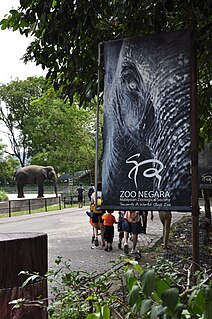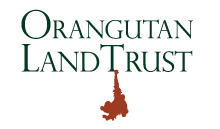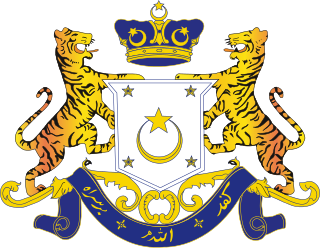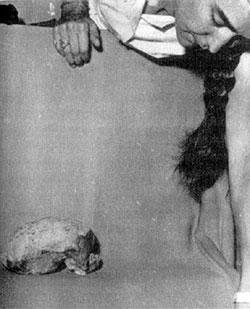
Sepilok Orangutan Rehabilitation Centre is located about 25 kilometres west of Sandakan in the state of Sabah, Malaysia.

Sandakan formerly known at various times as Elopura, is the capital of the Sandakan District in Sabah, Malaysia. It is the second largest town in Sabah after Kota Kinabalu. It is located on the east coast of the state in the administrative centre of Sandakan Division and was the former capital of British North Borneo. The town has an estimated population of 157,330 while the surrounding municipal area has a total population of 396,290.
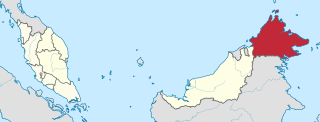
Sabah is a state of Malaysia located on the northern portion of Borneo Island. Sabah has land borders with the Malaysian state of Sarawak to the southwest, and Indonesia's Kalimantan region to the south. The Federal Territory of Labuan is an island just off the Sabah coast. Sabah shares maritime borders with Vietnam in the west and the Philippines to the north and east. Kota Kinabalu is the state capital city, the economic centre of the state and the seat of the Sabah state government. Other major towns in Sabah include Sandakan and Tawau. As of the 2015 census in Malaysia, the state's population is 3,543,500. Sabah has an equatorial climate with tropical rainforests and abundant animal and plant species. The state has long mountain ranges on the west side which form part of the Crocker Range National Park. Kinabatangan River, second longest river in Malaysia runs through Sabah and Mount Kinabalu is the highest point of Sabah as well as of Malaysia.

Malaysia is a country in Southeast Asia. The federal constitutional monarchy consists of 13 states and three federal territories, separated by the South China Sea into two similarly sized regions, Peninsular Malaysia and East Malaysia. Peninsular Malaysia shares a land and maritime border with Thailand in the north and maritime borders with Singapore in the south, Vietnam in the northeast, and Indonesia in the west. East Malaysia shares land and maritime borders with Brunei and Indonesia and a maritime border with the Philippines and Vietnam. Kuala Lumpur is the national capital and largest city while Putrajaya is the seat of federal government. With a population of over 30 million, Malaysia is the world's 44th most populous country. The southernmost point of continental Eurasia, Tanjung Piai, is in Malaysia. In the tropics, Malaysia is one of 17 megadiverse countries, with large numbers of endemic species.
Contents
The centre opened in 1964 as the first official orangutan rehabilitation project for rescued orphaned baby orangutans from logging sites, plantations, illegal hunting or kept as pets. [1] The orphaned orangutans are trained to survive again in the wild and are released as soon as they are ready. The sanctuary is located within the Kabili-Sepilok Forest Reserve which covers an area of 4,294 ha (10,610 acres), much of which is virgin rainforest. [2] Today around 60 to 80 orangutans are living free in the reserve. [3] It has become one of Sabah's tourist attractions. [4]

The orangutans are three extant species of great apes native to Indonesia and Malaysia. Orangutans are currently only found in the rainforests of Borneo and Sumatra. Classified in the genus Pongo, orangutans were originally considered to be one species. From 1996, they were divided into two species: the Bornean orangutan and the Sumatran orangutan. In November 2017 it was reported that a third species had been identified, the Tapanuli orangutan.

Rainforests are forests characterized by high rainfall, with annual rainfall in the case of tropical rainforests between 250 and 450 centimetres, and definitions varying by region for temperate rainforests. The monsoon trough, alternatively known as the intertropical convergence zone, plays a significant role in creating the climatic conditions necessary for the Earth's tropical rainforests.
In October 2014 the centre opened a new section where visitors can view the nursery area where the younger Orangutans first learn to be outside and play on a large climbing frame. This consists of 2 large indoor seating areas (one with air conditioning and one with fans only) with a large window that overlooks the play area. There is no additional charge to enter this part of the centre.
The Orangutan Rehabilitation Centre is neighboured to the Bornean Sun Bear Conservation Centre and shares veterinary facilities, personnel, parking, access roads and ticket gates. [5]

The Bornean Sun Bear Conservation Centre is a wildlife conservation and research centre for improving animal welfare and rehabilitation of the Malayan sun bear. It also aims to raise public awareness about the plight of the sun bears and to raise conservation awareness about this species.

Entry Costs (Malaysian/ Non-Malaysian nationals):
Adult- RM5/ RM30
Child- RM2/ RM15
Ticket is valid for the day of purchase, so you can attend both feeding times on the same ticket.
Camera Cost: RM10
Opening hours: Saturday to Thursday- 9am to 12pm and 2pm to 4pm. Fridays 9am-11am and 2pm to 4pm.
Orangutan feeding times: 10am and 3pm. It is recommended to arrive 30 minutes before feeding time.

Facilities: Souvenir shop, information center showing a video 6 times a day, cafe and toilets.
Getting there: Many organised tours leave from around Sabah at varying prices. Public bus #14 departs from Sandakan taking approximately 45–60 minutes, costing RM5. The Kota Kinabalu to Sandakan bus can also drop you at junction Jalan Sepilok, around 2.5 km from the Center. Journey approximately 5 hours from KK.
Taxis are usually available outside the centre (RM40 to Sandakan).



